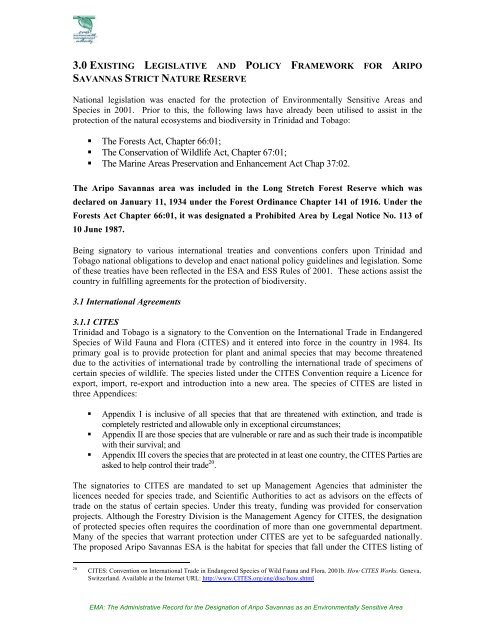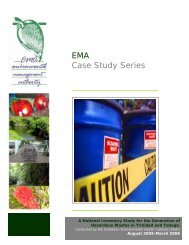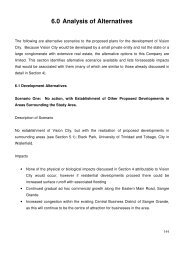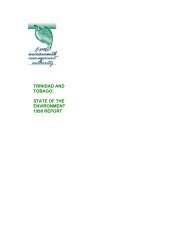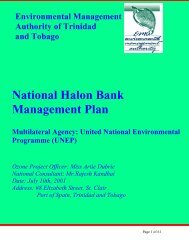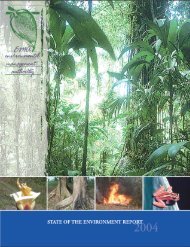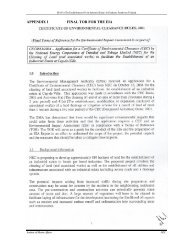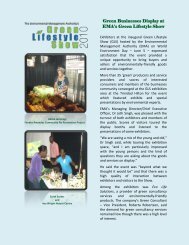Aripo Savannas Strict Nature Reserve - Environmental Management ...
Aripo Savannas Strict Nature Reserve - Environmental Management ...
Aripo Savannas Strict Nature Reserve - Environmental Management ...
You also want an ePaper? Increase the reach of your titles
YUMPU automatically turns print PDFs into web optimized ePapers that Google loves.
3.0 EXISTING LEGISLATIVE AND POLICY FRAMEWORK FOR ARIPO<br />
SAVANNAS STRICT NATURE RESERVE<br />
National legislation was enacted for the protection of <strong>Environmental</strong>ly Sensitive Areas and<br />
Species in 2001. Prior to this, the following laws have already been utilised to assist in the<br />
protection of the natural ecosystems and biodiversity in Trinidad and Tobago:<br />
The Forests Act, Chapter 66:01;<br />
The Conservation of Wildlife Act, Chapter 67:01;<br />
The Marine Areas Preservation and Enhancement Act Chap 37:02.<br />
The <strong>Aripo</strong> <strong>Savannas</strong> area was included in the Long Stretch Forest <strong>Reserve</strong> which was<br />
declared on January 11, 1934 under the Forest Ordinance Chapter 141 of 1916. Under the<br />
Forests Act Chapter 66:01, it was designated a Prohibited Area by Legal Notice No. 113 of<br />
10 June 1987.<br />
Being signatory to various international treaties and conventions confers upon Trinidad and<br />
Tobago national obligations to develop and enact national policy guidelines and legislation. Some<br />
of these treaties have been reflected in the ESA and ESS Rules of 2001. These actions assist the<br />
country in fulfilling agreements for the protection of biodiversity.<br />
3.1 International Agreements<br />
3.1.1 CITES<br />
Trinidad and Tobago is a signatory to the Convention on the International Trade in Endangered<br />
Species of Wild Fauna and Flora (CITES) and it entered into force in the country in 1984. Its<br />
primary goal is to provide protection for plant and animal species that may become threatened<br />
due to the activities of international trade by controlling the international trade of specimens of<br />
certain species of wildlife. The species listed under the CITES Convention require a Licence for<br />
export, import, re-export and introduction into a new area. The species of CITES are listed in<br />
three Appendices:<br />
Appendix I is inclusive of all species that that are threatened with extinction, and trade is<br />
completely restricted and allowable only in exceptional circumstances;<br />
Appendix II are those species that are vulnerable or rare and as such their trade is incompatible<br />
with their survival; and<br />
Appendix III covers the species that are protected in at least one country, the CITES Parties are<br />
asked to help control their trade 20 .<br />
The signatories to CITES are mandated to set up <strong>Management</strong> Agencies that administer the<br />
licences needed for species trade, and Scientific Authorities to act as advisors on the effects of<br />
trade on the status of certain species. Under this treaty, funding was provided for conservation<br />
projects. Although the Forestry Division is the <strong>Management</strong> Agency for CITES, the designation<br />
of protected species often requires the coordination of more than one governmental department.<br />
Many of the species that warrant protection under CITES are yet to be safeguarded nationally.<br />
The proposed <strong>Aripo</strong> <strong>Savannas</strong> ESA is the habitat for species that fall under the CITES listing of<br />
20 CITES: Convention on International Trade in Endangered Species of Wild Fauna and Flora. 2001b. How CITES Works. Geneva,<br />
Switzerland. Available at the Internet URL: http://www.CITES.org/eng/disc/how.shtml<br />
EMA: The Administrative Record for the Designation of <strong>Aripo</strong> <strong>Savannas</strong> as an <strong>Environmental</strong>ly Sensitive Area


